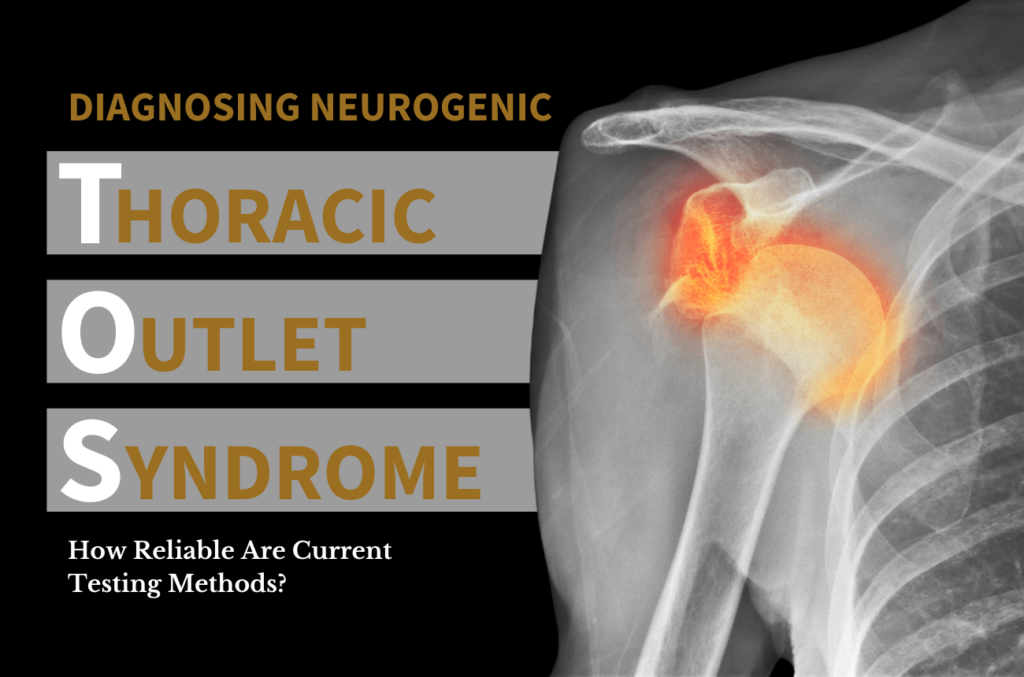Pain, numbness, tingling, swelling, weakness and impaired circulation can be signs of a number of different conditions and health issues, but the root of the problem can be difficult to pin down. In cases where many different conditions share symptoms, accurate diagnosis is key to help patients find relief and effective treatment. Thoracic outlet syndrome (TOS) is a group of conditions that often evade diagnosis.
TOS occurs when there is compression, injury or irritation of the nerves and/or blood vessels in the thoracic outlet located behind the collar bone. The most common type of TOS, neurogenic thoracic outlet syndrome (NTOS), occurs when anatomical abnormalities in the bony and soft tissues of the lower neck compress and irritate the brachial plexus nerves in the area. This irritation can cause pain, tingling, numbness, weakness and other debilitating symptoms in the neck, chest, arms and hands. These symptoms can often be confused with angina, carpal tunnel syndrome, cervical spine disease and others – and NTOS diagnosis often involves a long process of ruling out these conditions first.
One physical examination maneuver often used to identify NTOS is the elevated arm stress test (EAST). This test involves the patient positioning their arms upward at 90 degree angles and opening and closing their hands slowly over a three-minute period. While some forearm muscle fatigue is normal, a reproduction of pain, numbness and tingling in the neck, shoulder, arm and hand, along with the inability to complete the test due to early fatigue, may indicate the presence of NTOS. While the conventional EAST can assist in the diagnosis of NTOS and exclusion of other conditions, its accuracy and value in doing so reliably is debated.
As Director of the Washington University Center for Thoracic Outlet Syndrome at Barnes-Jewish Hospital, Robert Thompson, MD, is at the forefront of research and treatment of this rare and often elusive condition. In a recent pair of comprehensive studies, an international team of investigators, including Thompson and esteemed doctors and researchers from the Netherlands, examined the reliability and validity of the EAST as a diagnostic tool for NTOS. Thompson played a vital role in the conception and design of these studies, recently published in the Journal of Vascular Surgery.
TOS first caught Thompson’s interest when he became a member of Washington University faculty three decades ago. Since then, he has become one of the world’s leading TOS specialists and has devoted his entire clinical practice to the treatment of these syndromes. His significant contributions to the research and treatment of TOS include innovations in multidisciplinary evaluation and management, development and application of clinical diagnostic criteria, establishment of reporting standards, development and refinement of surgical techniques and clinical outcomes research for thoracic outlet syndromes.
In the first study, the investigators retrospectively reviewed the role of the conventional EAST in 428 patients with suspected NTOS from January 2017 to September 2018. They found a positive predictive value of 65%-66% and a negative predictive value of 53%-58%, highlighting the limitations of the conventional EAST as a single diagnostic test for NTOS.
To gain insight into improving the accuracy of the EAST, Thompson and his team then developed a standardized EAST-meter to help improve the consistency of patients’ posture and positioning during the test and more accurately measure grip strength and muscle fatigue. Using the EAST-meter and standardization methods, 426 patients with suspected NTOS and 147 healthy control patients were prospectively evaluated between October 2018 and February 2020. The data collected from these tests was then compared with data from 111 patients with surgically-confirmed cases of NTOS. The standardized EAST-meter, the study reports, also falls short of expected standards when it comes to reliably diagnosing NTOS. The results showed “low validity compared with symptomatic controls but moderate to high test-retest reliability.” While the standardized EAST may still not be optimal as a single diagnostic maneuver for NTOS, the study illustrated the potential of this test when applied elsewhere. Especially after the improvements made by the EAST-meter and standardizations developed for the study, results indicated the standardized EAST can be utilized more effectively as a tool in monitoring outcomes and functional improvement after surgical treatment.
These conclusions make it clear that more research is needed to develop optimal tests for identifying NTOS among the myriad of other conditions which cause similar symptoms. The results of the study also open doors for the utilization of the standardized EAST in monitoring and treatment plans for those already diagnosed with the condition. The authors state that further standardizations of the elevated arm stress test can improve physicians’ ability to monitor symptom progression or recovery before, during and after treatment.
In many cases of NTOS, surgery can effectively decompress the thoracic outlet to help relieve pressure on the nerves and to alleviate symptoms caused by nerve compression. There are several different approaches to TOS surgery, which can be performed by vascular and thoracic surgeons and other TOS specialists.
The Washington University Center for Thoracic Outlet Syndrome is one of the world’s leading centers for treating all forms of TOS. Led by Thompson, Washington University’s nationally and internationally recognized team has garnered remarkable experience with this rare condition due to the center’s high volume of cases. The team has also made significant contributions to research on topics such as diagnostic criteria and surgical outcomes for NTOS, limitations of ultrasound studies in NTOS and venous TOS, and long-term outcomes in cases of reoperation for recurrent NTOS.
Read more: Treating Recurrent NTOS
“We see a lot of patients who have suffered from symptoms for many, many years before they found us,” Thompson says of the center. “It’s still a thrill to see those kinds of patients do well after receiving treatment for thoracic outlet syndrome. It’s one of the things that keeps us going.”
